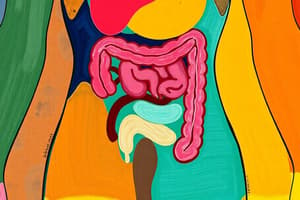Podcast
Questions and Answers
What are the main functions of the gastrointestinal tract (GIT)?
What are the main functions of the gastrointestinal tract (GIT)?
Ingestion, mechanical processing, digestion, secretion, absorption, excretion.
Which layer of the GIT is responsible for absorption?
Which layer of the GIT is responsible for absorption?
- Muscularis Externa
- Adventitia / Serosa
- Submucosa
- Mucosa (correct)
The peritoneum is a serous membrane that allows movement without friction.
The peritoneum is a serous membrane that allows movement without friction.
True (A)
The process of breaking down food into smaller molecules is called ______.
The process of breaking down food into smaller molecules is called ______.
What is the primary role of the mesentery?
What is the primary role of the mesentery?
What are the four main layers of the GIT?
What are the four main layers of the GIT?
What cells line the inner layer of the GIT mucosa?
What cells line the inner layer of the GIT mucosa?
Peritonitis can result from surgery or appendicitis.
Peritonitis can result from surgery or appendicitis.
Flashcards are hidden until you start studying
Study Notes
Digestive System Overview
- The Digestive System is responsible for digesting and absorbing nutrients, excreting waste products, and ingesting food.
- Key Processes:
- Ingestion: Taking food into the mouth (voluntary)
- Mechanical Processing: Crushing and propelling food (swallowing), prepares food for chemical breakdown
- Digestion: Chemically breaking down food into smaller molecules for absorption
- Secretion: Glandular organs/cells releasing water, enzymes, buffers, and acid into the digestive tract
- Absorption: Taking in essential nutrients like carbohydrates, lipids, proteins, vitamins, water, and minerals from the interstitial fluid
- Excretion: Removing waste products from the body
Peritoneum
- A serous membrane that encapsulates the abdominal cavity, lubricates, and separates the parietal from the visceral layers
- Parietal membrane lines the inner surface of the body wall
- Visceral membrane covers the organs of the peritoneal cavity (also known as serosa)
- 7L of fluid is moved in and out of the peritoneum daily, but a small volume (20ml) remains at any one time
Peritonitis
- Inflammation of the peritoneum, usually caused by surgery or appendicitis
- Clinical Signs: Abdominal swelling, redness
- Clinical Symptoms: Severe abdominal pain, heartburn, indigestion
Mesentery
- A double-layered sheet of peritoneum that anchors the intestines to the wall around the stomach, holding it in place
- Acts as an access route for blood, lymph vessels, and nerves
- Organs of the GIT are suspended and fixed within the peritoneal cavity by the mesentery
Histological Organization of the Digestive Tract
- Four layers of the GIT (alimentary canal)
- Mucosa: Innermost lining, composed of epithelium (enterocytes) and lamina propria
- Epithelium: Simple or stratified
- Lamina Propria: Loose irregular connective tissue, blood/lymph vessels, nerves, and muscularis mucosa
- Submucosa: Dense irregular connective tissue, larger blood/lymph vessels, exocrine glands (buffers & mucus), submucosal nerve plexus
- Muscularis Externa: Smooth muscle, responsible for movement of food along the digestive tract
- Adventitia/Serosa: Outermost layer, composed of connective tissue or epithelial tissue
- Mucosa: Innermost lining, composed of epithelium (enterocytes) and lamina propria
Layers of the GIT (alimentary canal): Mucosa & Submucosa
- Mucosa:
- Enterocytes (intestinal absorptive cells): Simple columnar epithelial cells that line the intestines
- Lamina propria: Connective tissue that supports the epithelium, containing blood and lymph vessels, nerves, and glands
- Goblet cells: Secretory cells that produce mucus
- Submucosa:
- Submucosal nerve plexus: Network of nerves that controls the muscularis mucosa and mucous glands.
- Dense irregular connective tissue: Provides support and flexibility
- Larger blood/lymph vessels: Deliver nutrients and oxygen and remove waste products
- Exocrine glands: Secretes mucus and buffers into the lumen of the digestive tract.
Studying That Suits You
Use AI to generate personalized quizzes and flashcards to suit your learning preferences.




